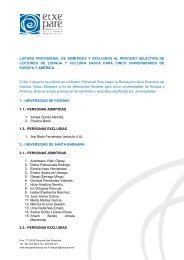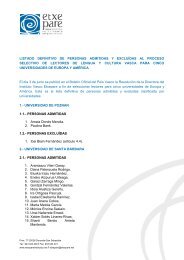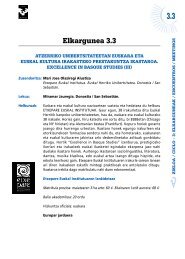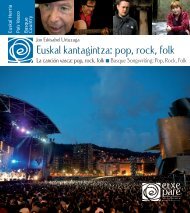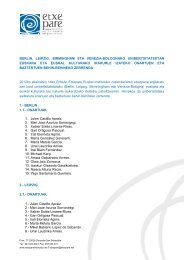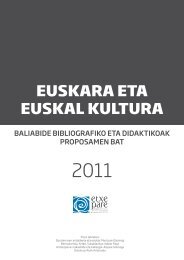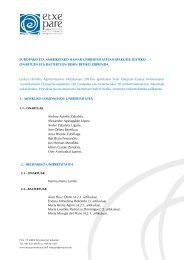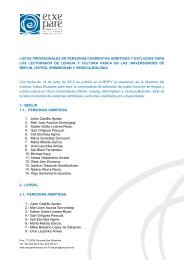XX. mendeko euskal literatura - Etxepare, Euskal Institutua
XX. mendeko euskal literatura - Etxepare, Euskal Institutua
XX. mendeko euskal literatura - Etxepare, Euskal Institutua
You also want an ePaper? Increase the reach of your titles
YUMPU automatically turns print PDFs into web optimized ePapers that Google loves.
ticipación de las mujeres en la <strong>literatura</strong> escrita en<br />
euskera. El número de mujeres escritoras es aún<br />
pequeño si lo comparamos al de los hombres (se<br />
cree que ronda el 15%). Por otra parte, partiendo del<br />
análisis realizado por Linda White (1996) la crítica<br />
feminista ha denunciado que la historiografía de la<br />
<strong>literatura</strong> vasca se ha basado hasta ahora en criterios<br />
androcéntricos (Olaziregi 1999). De todas maneras,<br />
la <strong>literatura</strong> escrita por mujeres ha ganado visibilidad<br />
en las últimas décadas a través de tesis doctorales<br />
(Núñez Betelu 2001, González 2007) e investigaciones<br />
académicas (Iris Zavala 2000; Gabilondo 2006).<br />
La novela breve Zergatik, panpox (1979) de Arantxa<br />
Urretabizkaia (1947) cuenta los avatares de un día<br />
en la vida de una madre abandonada por su marido<br />
hace cinco años y su hijo de siete años al que llama<br />
afectuosamente “Panpox”. Al igual que los trabajos<br />
publicados al hilo del “feminismo de la diferencia” en<br />
la década de 1970 en Francia, esta novela reflexiona<br />
sobre el rol de la mujer. En ese sentido, se hace referencia<br />
a las condiciones laborales de las mujeres,<br />
a la maternidad, al cuerpo de la mujer, entre otros.<br />
En su segunda novela, Saturno (1987), Urretabizkaia<br />
optó por un estilo narrativo más convencional. Esta<br />
novela muestra la relación amorosa entre un marinero<br />
alcoholizado y una enfermera llamada Maite.<br />
Tras un periodo de silencio que duró once años, la<br />
autora guipuzcoana publicó Koaderno gorria (1998).<br />
Dicha obra está organizada en dos planos: el primero,<br />
se centra en la carta que la protagonista, Ama (el<br />
nombre aparece en letras mayúsculas en el texto),<br />
escribe a sus hijos en un cuaderno rojo. Desde que el<br />
padre se llevara consigo a los niños siete años antes,<br />
la mujer no ha sabido de ellos. En un segundo plano,<br />
se nos ofrece el viaje a Venezuela de la abogada que<br />
la madre ha contratado para que entregue el cuaderno<br />
a sus hijos. Koaderno gorria reflexiona sobre<br />
la relación entre la maternidad y la nación o, para<br />
ser más exactos, sobre lo difícil que es compatibilizar<br />
la militancia política con la maternidad. La novela<br />
yed the lives of its protagonists, how it has taken<br />
away from them what they most loved in life. It is a<br />
gallery of characters without direction, like the geese<br />
mentioned at the beginning of the novel: after the<br />
Falangist uncle of Jesús used to cut their heads off,<br />
the geese would continue to walk for a while before<br />
falling wearily to the ground in a pool of blood. The<br />
novels of Muñoz, however, go further still, by linking<br />
the violence of the rebels during the Civil War with<br />
that of ETA.<br />
One of the most striking features of the literary panorama<br />
in the democratic era has been the participation<br />
of women in literature written in Euskara. The<br />
number of women writers is still small in comparison<br />
to that of men (it is believed to be around 15 per<br />
cent). Meanwhile, based on the research undertaken<br />
by Linda White (1996), a feminist critique has criticised<br />
the fact that, to date, the historiography of Basque<br />
literature has been based on androcentric criteria<br />
(Olaziregi 1999). Whatever the case, literature<br />
written by women has become markedly more visible<br />
in recent decades as a result of several doctoral<br />
theses (Núñez Betelu 2001, González 2007) and academic<br />
works (Iris Zavala 2000; Gabilondo 2006).<br />
The short novel Zergatik, panpox (1979) by Arantxa<br />
Urretabizkaia (1947) describes the ups and downs in<br />
a day in the life of a mother abandoned by her husband<br />
five years earlier and her seven-year-old son<br />
she affectionately calls Panpox. In the same way as<br />
novels published within the framework of the “feminism<br />
of difference” in France during the 1970s, this<br />
novel reflects on women’s roles. In this regard, it addresses<br />
women’s working conditions, motherhood<br />
and women’s bodies, amongst other topics. In her<br />
second novel, Saturno (1987), Urretabizkaia chose a<br />
more conventional narrative style. This novel is<br />
about the romantic relationship between an alcoholic<br />
sailor and a nurse called Maite. After an elevenyear<br />
silence, the author from Gipuzkoa then published<br />
Koaderno gorria (1998; The Red Notebook,<br />
37



